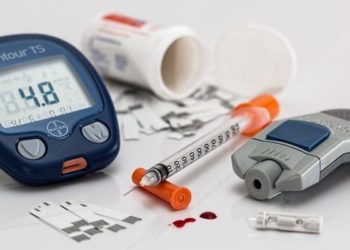Wellness Check: Nutrition
Treatment with semaglutide in patients with obesity may be associated with weight loss
1. In this study, treatment with semaglutide at any of the 5 doses approved for long-term weight management led to significant weight loss at 3 and 6 months after medication initiation.
2. Furthermore, higher doses of semaglutide led to greater weight reduction compared to lower doses.
Evidence Rating Level: 2 (Good)
Obesity is a highly prevalent and costly medical condition. Therefore, multiple weight loss interventions raging from lifestyle and behavioral changes to medication and surgical procedures have been developed and trialed in the past decades. Semaglutide is a glucagon-like peptide-1 receptor agonist originally approved to treat type 2 diabetes and recently approved for long-term weight management. However, there have been few studies assessing the relative effectiveness of semaglutide at the different doses approved for treating obesity.
This was a single-site retrospective cohort study based in the Mayo Clinic Health System that included 175 patients (75.4% female) with body mass index (BMI) of 27 or more. Patients were prescribed weekly semaglutide at doses of 0.25, 0.5, 1, 1.7, or 2.4 mg. Patients with a history of weight loss surgery or taking other anti-obesity medications were excluded. The primary outcome was percentage weight loss at 3 and 6 months after starting semaglutide, with further analysis stratified by patients with or without type 2 diabetes.
Results demonstrated that at 3 months, patients had a mean weight loss of 5.9%. Only 102 patients had follow-up at 6 months, with mean weight loss of 10.9%. At 6 months, 87.3% of patients achieved weight loss of 5% or more. Patients receiving higher approved doses (1.7 and 2.4mg) had more significant weight loss compared to patients receiving lower doses (0.25, 0.5, and 1mg) at 3 months (6.9% compared with 5.1%) and 6 months (12.1% compared with 9.2%). Lastly, patients with type 2 diabetes had less weight loss compared to those without at 3 months (2.9% vs 6.3%) and 6 months (7.2% vs 11.8%). However, this study was limited by potential unmeasured confounders such as other interventions provided by the weight loss clinic as well as lack of generalizability given the patient population was mainly White females. Nonetheless, these results suggest that for patients with obesity, semaglutide may be effective in weight loss across the range of approved doses.
Sustained low-carbohydrate diet may help prevent and manage type 2 diabetes
1. In this randomized controlled trial, sustained low-carbohydrate diet in patients with untreated hemoglobin A1c of 6.0%-6.9% led to improved hemoglobin A1c and glycemic control.
2. Furthermore, sustained low-carbohydrate diet in this patient sample led to decreased caloric intake and significant weight loss.
Evidence Rating Level: 2 (Good)
Type 2 diabetes (T2D) is rapidly increasing in prevalence and has a high disease burden in the United States (US). Diet plays a crucial role in managing T2D, and in patients with T2D, low carbohydrate diets have been shown to be associated with a reduction in hemoglobin A1c (HbA1c) in a linear fashion. However, whether a low-carbohydrate diet could have beneficial effects in patients with untreated diabetes or prediabetes has not been extensively studied.
This study was a randomized control trial that included 150 participants from Louisiana, US, aged 40 to 70 years old, with an HbA1c in the range of 6.0-6.9%. Participants with type-1 diabetes or currently on glucose-lowering medications were excluded. 75 participants were randomized to low-carbohydrate diet intervention (<40 net grams of carbohydrate for months 0-3 and <60g of carbohydrate for months 3-6) and 75 participants to usual diet. The intervention low-carbohydrate group also received weekly nutritional counseling. The primary outcome was change in HbA1c measured at 0, 3, and 6 months.
Compared to the usual diet group, the low-carbohydrate group had significantly greater reduction in HbA1c (-0.23% net difference) as well as fasting plasma glucose (-10.3mg/dL net difference) and body weight (-5.9kg net difference). However, this study was limited by the potential confounder of significant weight loss and decreased overall caloric intake in the low-carbohydrate group, which could have directly led to improved glycemic control independent of the low-carbohydrate nature of the diet. However, these results suggest that low-carbohydrate diet could be considered as an option for improved glycemic control for patients at high risk of T2D, warranting further studies with prolonged follow-up and direct comparison with other diet types.
Modifying advertising and nutrition labels helps reduce parental purchase of high-sugar beverages
1. In this study, adding disclosure about amount of added sugar to beverage packaging reduced parental choice of high-sugar beverages.
2. Furthermore, removal of labels such as “100% vitamin C” or fruit imagery reduced parental choice of high sugar beverages but did not modify perception of added-sugar content.
Evidence Rating Level: 1 (Excellent)
Childhood obesity and diabetes are growing public health challenges, with consumption of sugar-sweetened beverages (SSBs) being one risk factor. For children between the ages of one to eight, fruit drinks are one of the most consumed SSBs. Unfortunately, many front-of-package (FOP) labels on such drinks contain images of fruit with claims leading many parents to mistakenly believe that these drinks are healthy. The effectiveness of different options in modifying parental choice of beverages for their children have yet to be extensively studied.
This study was a randomized control trial of 5005 adult parents of children from the United States (US) between the age of zero to five. The racial and ethnic composition of participating parents was established to reflect the 2010 US census. Any parents who completed the survey in less than 5 minutes were excluded. Parents participated in an online survey and were shown no-, low-, and high-sugar beverages and asked to choose one for their child. Parents were randomized to see one of seven types of FOP labels, including a control group. The primary outcome measured were types of beverages chosen and added sugar and calorie of chosen beverage.
This study found that compared to the control group, disclosure of added sugar was the only modification that led to fewer parents (15.6%) choosing beverages with significantly fewer calories and added sugar. When claims of 100% vitamin C or fruit imagery were removed, 18.4% fewer parents chose a high-sugar beverage, choose 100% juice instead. This alternative selection, however, did not lead to any significant decreases in calories. However, this study was limited due to the lack of inclusion of pricing, which can heavily influence consumer choice. Nonetheless, these results suggest that there are packing modifications that can empower parents to choose healthier beverage purchases for their children.
©2022 2 Minute Medicine, Inc. All rights reserved. No works may be reproduced without expressed written consent from 2 Minute Medicine, Inc. Inquire about licensing here. No article should be construed as medical advice and is not intended as such by the authors or by 2 Minute Medicine, Inc.







